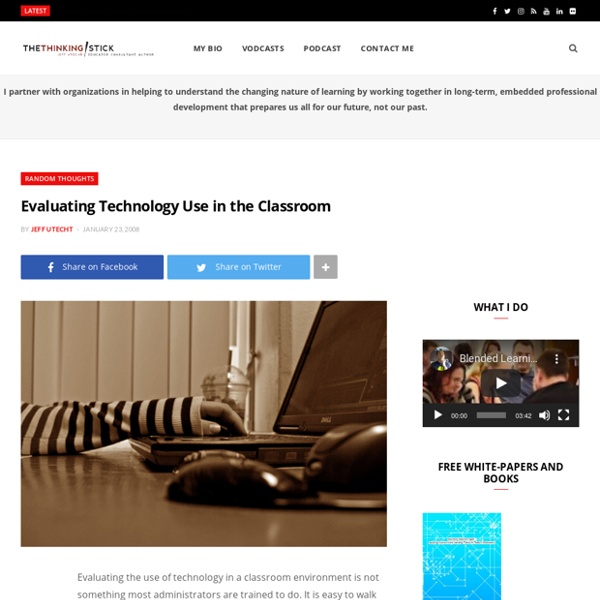Integrating Tech: More Than Just Having Computers
Technology has become part of the educational process, but too often it is separate and not integrated into the learning experience.Today, Education World offers easy and painless ways to integrate technology into your daily routine. Included: Nineteen activities and nearly 50 Web sites. Integrating technology into the curriculum is a priority -- if not a mandate -- in most schools today. Most educational technology experts agree, however, that technology should be integrated, not as a separate subject or as a once-in-a-while project, but as a tool to promote and extend student learning on a daily basis. The challenge, of course, is in finding ways to use technology -- and to help students use it -- that don't take time away from core subjects.
High-Tech Teaching in a Low-Tech Classroom
By Jennifer L. Barnett As 21st-century teachers, we are expected to help students master the technological tools they will use in college and the workplace.
making SAMR work for us – …have laptop, will travel
Technology, when integrated into the curriculum, revolutionizes the learning process. Teachers who recognize computers as problem-solving tools change the way they teach. They move from a behavioral approach to a more constructivist approach.From edutopia.org The Background Info: I think to fully understand some of the things that I will talk about in this post, I need to give you a quick rundown of the current setup we have going at my school.
[Let’s Make Communication Great Again] — How the Nature of Words Should Impact Your Communication
Now for the quote: “The finger pointing at the moon isn’t the moon.” It’s a great way to explain meta-physics, but it also accurately describes how words & language works. Where Does Language Come From?
Plenary session by Joy Egbert
About the session Engagement principles and practice in classroom learning, language and technology A still-common issue with technology use in language learning is an overly-strong focus on the digital tools and a relatively weak emphasis on actual learning. This technocentric approach may arise, in part, from a lack of clear theoretical grounding for classroom technology use. While it's unclear whether atheoretical uses of technology actually provide barriers to learning, it is clear from the research that principled uses can lead to student achievement. But which principles should language educators use to guide their planning?
8 Examples of Transforming Lessons Through the SAMR Cycle
The SAMR Model for integrating technology into teaching, developed by Dr. Ruben Puentedura, has gained a good deal of exposure in recent years. “SAMR” is an acronym that stands for Substitution, Augmentation, Modification, and Redefinition. The SAMR model provides a technique for moving through degrees of technology adoption to find more meaningful uses of technology in teaching and move away from simply using “tech for tech’s sake”.
Is the Era of Voice Texting Upon Us?
Once upon a time, it was as stylish to hate voicemail as it is to hate Facebook. In the eyes of digital-savvy critics, spoken audio messages were an inconvenient ’80s relic with embarrassing conventions that dated baby boomers and repulsed millennials. The smartphone was a ubiquitous life accessory that gave society the gift of texting, a far more efficient form of communication. “Think of how long it takes to access your voicemail and listen to one of those long-winded messages,” read a 2013 “digital etiquette” column in The New York Times. “‘Hi, this is so-and-so …’ In text messages, you don’t have to declare who you are, or even say hello.” Gawker (rest its soul) followed up with a far more radical guide titled “Don’t Leave Me a Voicemail Unless You’re Dying.”
How students can use mobiles to learn English
Mobile technology is everywhere, but do you restrict or encourage it in your classroom? Educator, multimedia author and editor Joanna Norton shares tips about how English language teachers can use technology to their learners’ benefit. Technology is transforming how we communicate, socialise, play, shop and conduct business. These profound changes place pressure on the traditional models of language learning, such as teaching in a formal classroom setting. They also present us with amazing opportunities to re-design the way we teach and learn English. Teaching with desktop computers vs mobile devices
Push My Thinking: TPACK or SAMR or ? – ED TECH COACHING
**Update 4/26/14: I LOVE the responses to this post; they made me consider a lot of different ways of looking at TPACK and SAMR, and really stretched my thinking. If you read this post, also read the comments- and check out the links that some people have included!I’m going to preface this post by saying that I think both TPACK and SAMR are incredibly useful frameworks- and I use them a lot in my work with education technology. While I don’t want to completely discount either framework in this post, I do want to start a discussion- and explain why I am currently not finding them completely effective in my work with teachers. TPACK looks at the collaboration between technology, pedagogy, and content and argues that teachers need knowledge of all three.



